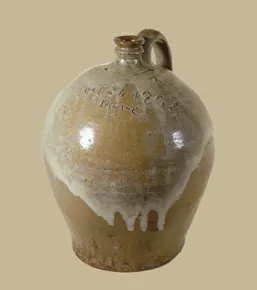
Audio
Carrie Stewart and Gerald Stewart, Louisville, Winston County. Interview recorded June 1981. Gerald Stewart came from a deeply rooted family potting tradition. By 1888, his father Homer Wade Stewart...
South Carolina, with its rich clay deposits, is the home to two different, but very important ceramic traditions - Catawba earthenware and alkaline-glazed stoneware. Before European contact in the 16th century, the Catawba Nation controlled much of what is now South Carolina and most of the North Carolina Piedmont. This tradition has continued through elder potters sharing their knowledge and skills with younger generations. While their techniques remain ancient, they have adapted their forms to changing markets. Kinship and community were also important in the development and diffusion of the alkaline-glazed stoneware tradition during the nineteenth century. Using European and African forms and labor the Edgefield, South Carolina, potteries produced containers used primarily for food preservation and preparation. As some potters migrated west and to other areas in the southeast, they spread the alkaline-glazed tradition into Georgia, North Carolina, Alabama and Mississippi.
Content is provided by McKissick Museum, University of South Carolina.
For further information about any of the artists featured on Digital Traditions, send your questions and comments to hallagan@mailbox.sc.edu.

Audio
Carrie Stewart and Gerald Stewart, Louisville, Winston County. Interview recorded June 1981. Gerald Stewart came from a deeply rooted family potting tradition. By 1888, his father Homer Wade Stewart...
Audio
Hewell Pottery, Gillsville, Banks County. Interview recorded with family members in June 1981. The Hewell family potting dynasty began with Nathaniel H. Hewell (1832-1887). For years, the Hewell...
Audio
"Hattie Mae Stewart Brown talks about pottery involvement." The daughter of Mississippi potter Homer Wade Stewart, Hattie Mae married journeyman potter Horace “Jug” Brown. She met Brown when he worked...
Audio
"Three things about a potter, according to Horatio Boggs." Horatio Boggs is descended from a long line of family potters with roots in Alamance County, North Carolina. Like many other potters in the...
Audio
Matthews Pottery, Matthews, Mecklenburg County. Interview recorded 9 July 1981. The Outens had been in the pottery business since the 1870s, working in both North and South Carolina. Kenneth Outen...
Audio
Marie Gooden Rogers, Rogers Pottery, Meansville, Upson County. Interview recorded June 1981. Marie Gooden married into a potting family and was given informal instruction in shop operations and the...
Audio
Norman Smith (d. 1990), Lawley, Chilton County. Interview recorded June 1981. Norman Smith began working in the family pottery in 1920 and opened his own shop in 1932 a few miles away. Arguably one of...
Audio
Otis Norris, Sandhills Pottery, McBee, Chesterfield County. Interview recorded May 2007. A Kershaw County native, Otis Norris has been turning pots at his current location in Chesterfield County since...
Audio
Sara Ayers talks with Cinda Baldwin about animal figures in her pottery. Sara Ayers was a highly accomplished Catawba potter who exemplified the major artistic tradition of South Carolina's earliest...
Audio
Duncan Pottery, Amory, Monroe County. Interview recorded June 1981. Verna Suggs Duncan assisted her father, William D. Suggs (1878-1945) at his pottery in the town of Smithville in eastern Mississippi...